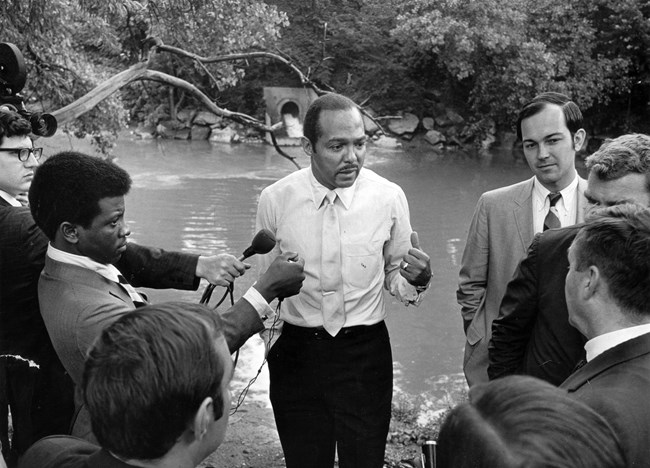Carl Stokes is famously known for being the first Black Mayor of Cleveland, elected in 1967, and famously forgotten as a catalyst in the creation of the Environmental Protection Agency (EPA) and Clean Water Act. Stokes didn't run on an environmentalist platform; instead, he focused on issues that affected Cleveland's people: the polluted river and water sources. In 1968, Stokes and his utility director championed the proposal to clean up the city rivers and rallied Cleveland voters to pass a $100 million bond to do so. While it was a step forward, Stoke recognized "the river flowed through too many places before reaching Cleveland" and he couldn't control the water there. More needed to be done. In June 1969, Stokes saw an opportunity for large-scale change.
To Cleveland insiders and outsiders alike, the Cuyahoga River Fires are an infamous event. A river that was so polluted, "it oozes, rather than flows" and had a tendency to catch on fire, not once, but 13 times. Carl Stokes inherited the issue of a flaming river, the first fire happening back in 1868. In 1969, Stokes' second year as mayor and 101 years after the first fire, a spark from a passing rail car ignited an oil slick on the river, causing a fire that was small and relatively harmless compared to others. What happened after was an even bigger media spark.
The very next day, Stokes took the local media on a Pollution Tour along the Cuyahoga River, visiting the location of the fire, an industrial site, and sewers that contributed to pollution. While his media tour highlighted the issue locally, it wasn't until Time magazine published a story and picture of the Cuyahoga river ablaze—using a picture from the 1962 fire, a larger and more damaging fire—that the nation finally tuned in. After this, environmental concerns took the national stage. Mayor Stokes gave a Congressional testimony on "his and other major big cities' struggles with polluting industries to restore the environmental health of their communities," an issue that was personal to mayor Stokes.
Carl Stokes grew up with his mother, Louise Stone Stokes, and brother Louis Stokes in Cleveland's first federally funded public housing, the Outhwaite. Stokes recognized that the pollution issues affected the community where he grew up and where his voters lived, more than others in the suburbs. Stokes' environmental concerns are more aligned to what we call Environmental Justice today. Mayor Stokes also recognized that his city alone couldn't help curtail the rampant pollution that ended up on Cleveland's shores. He needed other towns nearby and the federal government’s help. Mayor Stokes and his brother Louis, a former U.S. Congressman, both testified in front of Congress, urging greater federal involvement in pollution control. With others in the government’s help, they rallied around the cause, ensuring that change would come. And it did. By the end of 1969, President Nixon signed an executive order creating the U.S. Environmental Protection Agency. In 1972, the Clean Water Act became law. Despite Stokes being a large figure in this movement, he's often left out of this narrative of the creation of the EPA, even though he helped gain the nation's attention.
Carl Stokes was ahead of his time. As an environmentalist that listened to people often ignored in any conversation. Stokes was at the start of the Environmental Justice movement. One concerned with the effects of pollution on the environment AND the people who were most affected by pollution, predominantly poor minority communities. Stokes goal was to help the people who were harmed by the changing environment. The environmental justice movement would blow up in the late 1980’s, almost 10 years after he was mayor. A blistering report exposed massive disparities in the burden of environmental degradation and pollution facing minority and low-income communities. In the 1990’s, Bill Clinton made environmental justice central to his administration, which created some change. But even in Cleveland today, we still see the effects on the East Side of Cleveland. Sierra Club’s Jocelyn Travis explores the issue in her blog post, “Racial Justice Organizing Is Environmental Justice Organizing.”
As we move work to protect the environment, remember to advocate and champion the Black, Indigenous, and people of color communities who are often affected most.
If you don’t know where to start, Jocelyn Travis says it best “People know what they need. They just need to be heard.”
Resources
Carl B. Stokes and the 1969 River Fire
Reflections On The Cuyahoga River Fire’s Golden Anniversary
Carl B. Stokes and the 1969 River Fire
NPR 50 Years Later: Burning Cuyahoga River Called Poster Child for Clean Water Act
NPR 50 Years Later: Burning Cuyahoga River Called Poster Child for Clean Water Act
Carl B. Stokes and the 1969 River Fire
NPR 50 Years Later: Burning Cuyahoga River Called Poster Child for Clean Water Act
Sierra Club Resources about Environmental Justice and Addressing Racism
Picture: Mayor Carl B. Stokes gives a pollution tour for the press right after the 1969 Cuyahoga River fire. Source: The City of Cleveland
